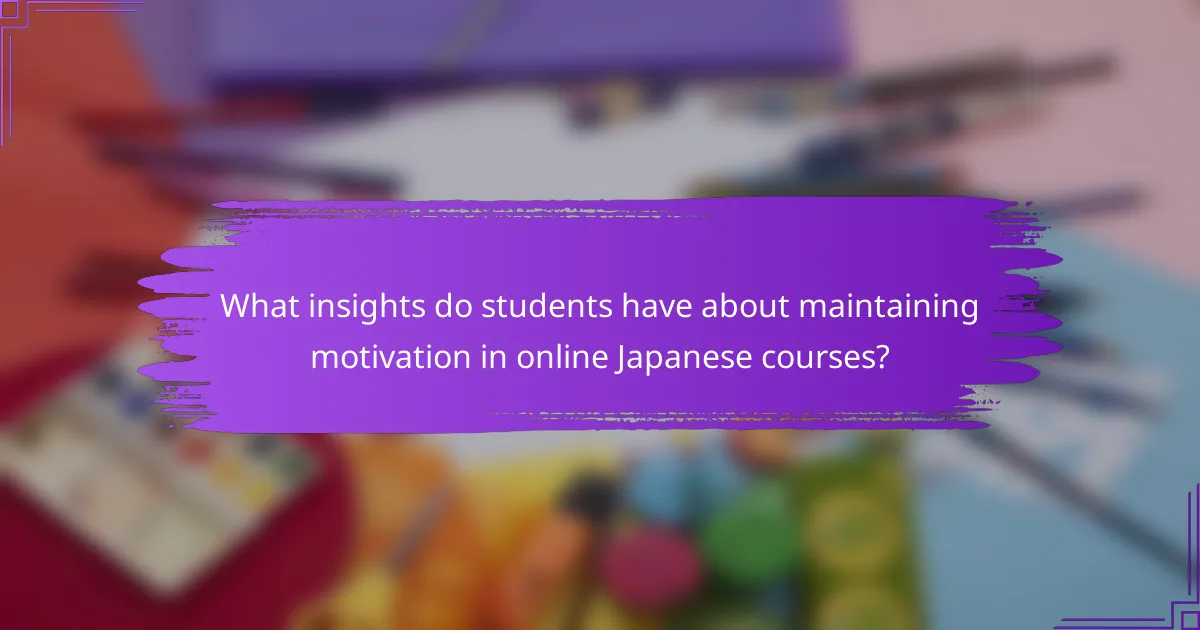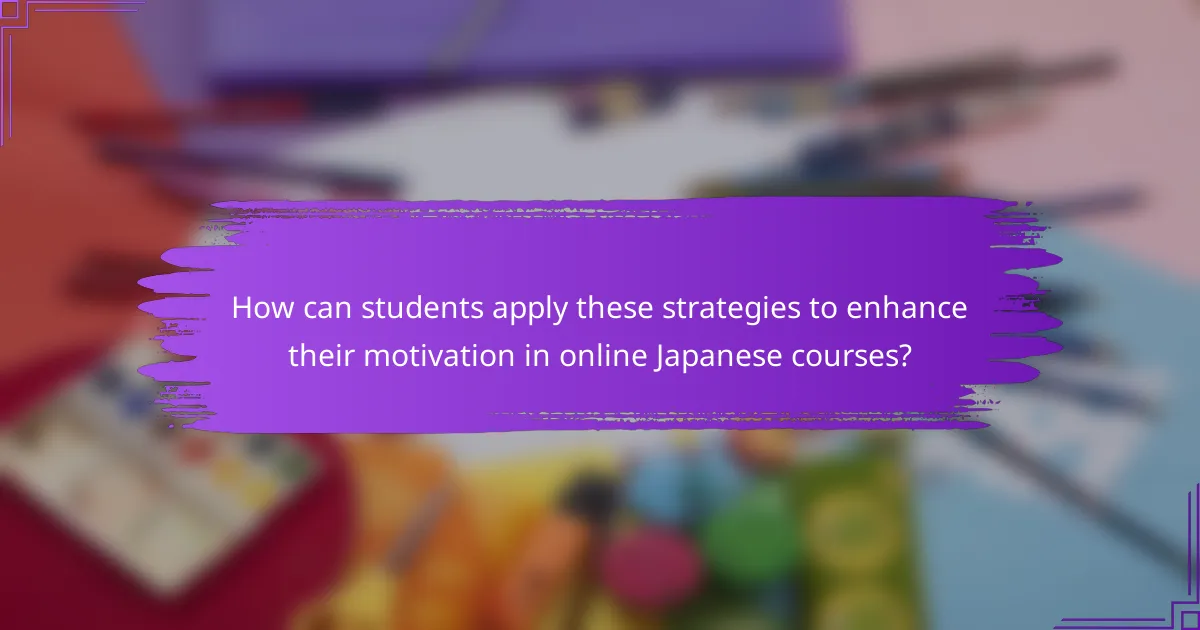
What are Effective Strategies for Maintaining Motivation in Online Japanese Courses?
Effective strategies for maintaining motivation in online Japanese courses include setting clear goals, creating a structured study schedule, and engaging with interactive content. Setting specific, measurable goals helps learners track progress. A structured schedule promotes consistency and discipline in learning. Interactive content, such as games and quizzes, keeps learners engaged and makes studying enjoyable. Additionally, joining online study groups fosters a sense of community and accountability. Regularly reviewing progress can reinforce motivation by highlighting achievements. These strategies collectively enhance the learning experience and sustain motivation throughout the course.
How can setting clear goals enhance motivation in online language learning?
Setting clear goals enhances motivation in online language learning by providing direction and focus. Clear goals help learners understand what they want to achieve. This understanding fosters a sense of purpose. When students set specific, measurable, attainable, relevant, and time-bound (SMART) goals, they can track their progress effectively. Studies show that goal-setting increases engagement. For instance, a study by Locke and Latham (2002) found that specific goals lead to higher performance compared to vague goals. This structured approach encourages consistent effort and perseverance. As students achieve their goals, they experience a sense of accomplishment. This accomplishment further boosts their motivation to continue learning.
What types of goals should students set for their Japanese studies?
Students should set specific, measurable, achievable, relevant, and time-bound (SMART) goals for their Japanese studies. These goals can include mastering a certain number of vocabulary words each week. For example, students might aim to learn 50 new words weekly. Another goal can be to complete a specific textbook chapter by a set date. This ensures consistent progress in reading and comprehension skills. Additionally, students can set goals for practicing speaking with native speakers for at least 30 minutes each week. This enhances conversational skills and fluency. Setting goals for writing essays or journal entries in Japanese can also improve writing proficiency. Tracking progress toward these goals fosters motivation and accountability. Research shows that goal-setting significantly increases student engagement and success in language learning.
How can students track their progress towards these goals?
Students can track their progress towards their goals by using various tools and methods. They can maintain a learning journal to document daily achievements and challenges. Online platforms often provide progress tracking features, such as dashboards displaying completed lessons and quizzes. Regular self-assessment through quizzes can help students gauge their knowledge retention. Setting specific milestones and deadlines creates a clear roadmap for progress. Utilizing apps that track language learning can provide insights into vocabulary acquisition and practice hours. Engaging in peer discussions can also offer feedback on progress. These methods collectively enhance accountability and motivation in online Japanese courses.
Why is a structured learning environment important for motivation?
A structured learning environment is important for motivation because it provides clarity and consistency. Clear expectations help students understand what is required of them. Consistent routines foster a sense of security and stability. Structure allows learners to track their progress effectively. Research indicates that students perform better in environments with defined goals and timelines. A study by the National Center for Education Statistics shows that structured programs lead to higher engagement levels. Therefore, a structured environment supports motivation by creating a conducive atmosphere for learning.
What elements contribute to an effective online learning environment?
An effective online learning environment includes clear communication, engaging content, and supportive technology. Clear communication fosters understanding between instructors and students. Engaging content keeps students motivated and interested in the material. Supportive technology ensures that students can easily access resources and participate in discussions. Research indicates that these elements lead to higher student satisfaction and retention rates. For instance, a study by the Online Learning Consortium found that 70% of students prefer interactive learning experiences.
How can students create a personalized study space at home?
Students can create a personalized study space at home by selecting a quiet area with minimal distractions. This space should be well-lit and comfortable to enhance focus. Students should arrange their study materials and tools within easy reach. Personalizing the area with motivational quotes or images can boost inspiration. Using ergonomic furniture can improve comfort during long study sessions. Incorporating plants can enhance the atmosphere and air quality. Keeping the space organized helps maintain clarity and focus. A dedicated study space can significantly improve productivity and motivation.
What role do social interactions play in maintaining motivation?
Social interactions significantly enhance motivation in online learning environments. They provide emotional support and foster a sense of belonging among learners. Engaging with peers can lead to shared goals and accountability. This interaction often encourages individuals to persist in their studies. Research shows that collaborative learning improves motivation and retention rates. A study by the National Education Association found that students who interact socially are more likely to stay motivated. Such connections can lead to increased participation in discussions and activities. Overall, social interactions are crucial for sustaining motivation in online Japanese courses.
How can students engage with peers in online Japanese courses?
Students can engage with peers in online Japanese courses through various interactive methods. Participating in discussion forums allows students to share insights and ask questions. Group projects foster collaboration and deepen understanding of the material. Online study groups enable students to practice speaking and listening skills together. Utilizing social media platforms can help students connect and share resources. Engaging in language exchange programs offers real-life conversation practice. Regular virtual meetups can enhance peer interaction and community building. These methods promote motivation and enhance language learning outcomes.
What platforms facilitate interaction among Japanese language learners?
Online platforms that facilitate interaction among Japanese language learners include language exchange websites, social media groups, and dedicated language learning apps. Websites like Tandem and HelloTalk connect learners with native speakers for real-time conversation practice. Social media platforms such as Facebook and Discord host groups where learners can share resources and experiences. Language learning apps like Duolingo and Busuu offer community features that allow users to engage with each other. These platforms enhance language acquisition through interactive dialogues and peer support.
What tools and resources can support motivation in online learning?
Interactive learning platforms enhance engagement in online learning. Tools like Kahoot and Quizlet provide gamified quizzes. These platforms encourage participation through competition and rewards. Video conferencing tools, such as Zoom, foster real-time interaction. They enable discussions and collaborative learning experiences. Goal-setting apps, like Trello or Asana, help students track progress. These tools promote accountability and motivation through visual reminders. Online communities, such as forums or study groups, offer peer support. They create a sense of belonging and shared goals. Lastly, educational resources like Duolingo provide structured learning paths. These resources keep learners motivated with clear milestones and achievements.
Which apps are recommended for practicing Japanese outside of class?
Duolingo is a highly recommended app for practicing Japanese outside of class. It offers interactive lessons that cover vocabulary and grammar. Users can practice reading, writing, listening, and speaking skills. Anki is another effective app that uses spaced repetition for vocabulary retention. This app allows users to create custom flashcards. Tandem connects learners with native speakers for language exchange. It provides real-time conversation practice. HelloTalk is similar, facilitating text and voice exchanges with native Japanese speakers. These apps are popular among learners for their engaging formats and effectiveness in language acquisition.
How can multimedia resources enhance the learning experience?
Multimedia resources enhance the learning experience by providing diverse content formats. They include videos, audio, images, and interactive elements. This variety caters to different learning styles. For instance, visual learners benefit from videos and infographics. Auditory learners gain from podcasts and recorded lectures. Interactive resources, like quizzes and games, engage students actively. Research indicates that multimedia can improve retention rates by up to 60%. This is due to increased engagement and interaction with the material. Furthermore, multimedia resources can simplify complex concepts through visual representation. Overall, these resources create a more dynamic and stimulating learning environment.

What insights do students have about maintaining motivation in online Japanese courses?
Students maintain motivation in online Japanese courses by setting clear goals and establishing a routine. They find that breaking lessons into manageable chunks enhances focus. Engaging with interactive content, like games and quizzes, keeps learning enjoyable. Regularly practicing speaking with peers or tutors boosts confidence and retention. Many students emphasize the importance of a supportive community for encouragement. Tracking progress visually, such as through charts or apps, reinforces a sense of achievement. Personalizing learning experiences by choosing topics of interest increases intrinsic motivation. Lastly, students often recommend scheduling regular breaks to prevent burnout and maintain enthusiasm.
What challenges do students face in staying motivated?
Students face several challenges in staying motivated during online courses. One significant challenge is the lack of face-to-face interaction. This absence can lead to feelings of isolation, reducing engagement. Another challenge is the overwhelming amount of coursework. Students often struggle to manage their time effectively, leading to burnout. Distractions in a home environment also pose a problem. Many students find it difficult to focus amid household activities. Additionally, unclear goals can hinder motivation. Without specific objectives, students may lose direction and purpose. Lastly, varying levels of self-discipline affect motivation. Some students may lack the intrinsic drive needed for online learning. These factors collectively contribute to the difficulties students experience in maintaining motivation.
How do these challenges differ among various learners?
Challenges in online Japanese courses differ among various learners based on their individual backgrounds and learning styles. For instance, beginners may struggle with foundational vocabulary and grammar, while advanced learners might face challenges in maintaining fluency. Visual learners often benefit from interactive tools but may find traditional text-heavy materials less engaging. Auditory learners may excel with listening exercises but could struggle with reading comprehension. Cultural background also plays a role; learners familiar with Japanese culture might find context easier to grasp. Additionally, learners with different levels of prior language experience exhibit varied motivations and challenges. Research indicates that personalized learning approaches can address these differences effectively.
What common strategies do students use to overcome these challenges?
Students commonly use time management and goal-setting strategies to overcome challenges in online Japanese courses. Effective time management involves creating a structured schedule that allocates specific times for study. This helps students stay organized and reduces procrastination. Goal-setting allows students to establish clear, achievable objectives. Breaking larger tasks into smaller steps makes learning more manageable and less overwhelming.
Additionally, students often engage with peers for support and accountability. Study groups or online forums provide a sense of community and motivation. Utilizing various learning tools, such as language apps and flashcards, enhances the learning experience. These strategies collectively contribute to improved motivation and better outcomes in online Japanese courses.
What tips do successful students share about their motivation strategies?
Successful students share various motivation strategies to enhance their learning. They set specific, achievable goals to track progress. Breaking tasks into smaller steps helps maintain focus and reduces overwhelm. Establishing a consistent study schedule promotes discipline and routine. Many students also utilize positive reinforcement, rewarding themselves for completing tasks. Engaging with peers or study groups fosters accountability and support. Visualization techniques, such as imagining success, can boost motivation. Lastly, reflecting on personal reasons for learning Japanese keeps the passion alive.
How can students incorporate fun into their language learning routine?
Students can incorporate fun into their language learning routine by engaging in interactive activities. These activities include language games, quizzes, and challenges. Students can use apps like Duolingo or Memrise that gamify the learning process. Watching Japanese movies or anime with subtitles adds entertainment while improving comprehension. Participating in language exchange meetups enhances speaking skills and makes learning social. Listening to Japanese music or podcasts can also make learning enjoyable. Incorporating these fun elements can lead to increased motivation and retention of the language. Studies show that enjoyable learning experiences enhance language acquisition and engagement.
What habits do motivated learners adopt to stay engaged?
Motivated learners adopt several habits to stay engaged. They set specific goals to create a clear learning path. This helps them maintain focus and direction. Regularly reviewing their progress reinforces their commitment. Engaging in active learning techniques enhances retention and understanding. These techniques include summarizing information and teaching others. Additionally, they utilize varied resources to keep their studies interesting. This can involve using multimedia tools and interactive platforms. Building a supportive learning community encourages accountability and motivation. These habits collectively foster a sustained interest in learning.

How can students apply these strategies to enhance their motivation in online Japanese courses?
Students can enhance their motivation in online Japanese courses by setting specific goals. Clear, achievable objectives provide direction and purpose. Additionally, they can engage with interactive content, such as language games and quizzes. This approach makes learning enjoyable and reinforces knowledge.
Regularly participating in discussion forums fosters a sense of community. Interaction with peers encourages accountability and support. Using a variety of resources, like videos and podcasts, caters to different learning styles. This diversity keeps the learning experience fresh and interesting.
Establishing a consistent study schedule helps create a routine. Consistency is key to maintaining motivation over time. Tracking progress through self-assessment tools can provide a sense of accomplishment. This feedback reinforces the value of their efforts.
Lastly, students should reward themselves for reaching milestones. Positive reinforcement can boost motivation and make learning more rewarding.
What practical steps can students take to implement motivation strategies?
Students can implement motivation strategies by setting clear and achievable goals. Establishing specific objectives helps maintain focus and direction. Creating a study schedule ensures consistent progress. Allocating dedicated time for learning reinforces commitment. Utilizing diverse learning resources enhances engagement. Incorporating interactive tools, like language apps, makes learning enjoyable. Joining study groups fosters accountability and collaboration. Tracking progress provides a sense of achievement. Research shows that goal-setting and social support significantly improve motivation in educational settings.
How can students create a balanced study schedule that maintains motivation?
Students can create a balanced study schedule by setting specific goals and allocating time for each subject. They should prioritize tasks based on deadlines and difficulty. Incorporating breaks is essential for maintaining focus and avoiding burnout. Utilizing tools like planners or digital apps can help organize study sessions effectively. Regularly reviewing progress boosts motivation and helps adjust the schedule as needed. Research shows that structured study times improve retention and engagement. A balanced approach ensures students remain motivated throughout their learning journey.
What are some effective self-care practices to support language learning motivation?
Effective self-care practices to support language learning motivation include regular breaks and physical activity. Taking breaks prevents mental fatigue and enhances focus. Engaging in physical activity boosts mood and cognitive function. Mindfulness practices, such as meditation, can reduce anxiety related to learning. Setting realistic goals helps maintain motivation and provides a sense of accomplishment. Connecting with language learning communities fosters social support and encouragement. Lastly, maintaining a balanced diet improves overall energy levels and mental clarity. These practices collectively enhance motivation and facilitate effective language learning.
What are the best practices for sustaining motivation over the long term?
Setting specific, achievable goals sustains long-term motivation. Clear objectives provide direction and a sense of purpose. Tracking progress towards these goals reinforces commitment. Utilizing rewards for milestones can enhance motivation. Engaging with a supportive community fosters accountability. Regularly revisiting and adjusting goals keeps them relevant. Incorporating variety in learning methods prevents monotony. Lastly, maintaining a positive mindset is crucial for overcoming challenges.
How can students periodically reassess their goals and motivations?
Students can periodically reassess their goals and motivations by setting specific intervals for reflection. For instance, they can choose to evaluate their progress every month. During these evaluations, students should review their initial goals and determine if they are still relevant. They can also analyze their achievements and identify areas for improvement. Journaling can be an effective tool for this reflection process. By writing down thoughts and feelings, students gain clarity on their motivations. Additionally, seeking feedback from peers or instructors can provide new perspectives. Research indicates that regular self-assessment enhances goal alignment and motivation. Studies show that students who engage in self-reflection are more likely to stay committed to their learning objectives.
What role does reflection play in maintaining motivation in language studies?
Reflection plays a crucial role in maintaining motivation in language studies. It allows learners to assess their progress and identify areas for improvement. This self-assessment fosters a sense of ownership over the learning process. When students reflect on their achievements, they reinforce their commitment to their goals. Research indicates that reflective practices can enhance intrinsic motivation. For instance, a study published in the Journal of Language Learning found that learners who engaged in regular reflection reported higher motivation levels. Reflection helps students connect their learning experiences to personal goals, making the study of language more meaningful.
Strategies for maintaining motivation in online Japanese courses focus on setting clear goals, creating structured study schedules, and engaging with interactive content. Key insights include the importance of social interactions, personalized study spaces, and the use of various tools and resources to enhance the learning experience. Students face challenges such as lack of face-to-face interaction and time management but can overcome these through effective strategies like goal-setting and peer engagement. The article also highlights practical steps for sustaining motivation over the long term, including regular reflection on progress and self-care practices.